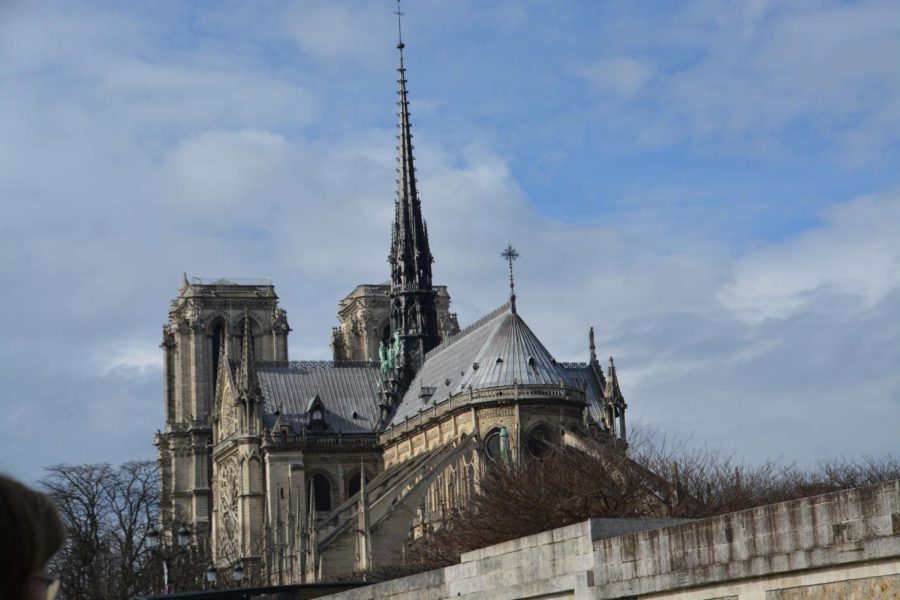Une Journee a Paris (A Day Trip to Paris)
March 10, 2023
During my family’s week-long stay in London in 2018, we took a day trip to Paris. While the two cities seem far away, the plan is not as ambitious as it sounds. London and Paris are connected by one of the fastest, most modern forms of transportation, the Eurostar. To arrive in Paris, the Eurostar must go underneath the English Channel, which spans 21 miles and travels 246 feet below sea level. The channel connects Dover, England, Calais, and France. Once the Eurostar arrives in Calais, it travels another 147 miles to reach Paris.
As the train arrived at Gard Du Nord Station, in Paris, France, I could already hear the whistles and the clicks of shoes on the pavement. After leaving the station, my family boarded a tour bus for a panoramic sightseeing tour through the city of Paris. While Paris is clearly in the modern world, the city still maintains its historical integrity.
Our bus passed through the Grands Boulevard, the first great promenade of Paris. The Boulevard is a symbol of the way the people of Paris lived during the 19th century. Next, the bus passed by the Paris Opera House, a 1,979-seat opera house that still hosts ballets and operas. It is most famous for the setting of the Phantom of the Opera, by Gaston Leroux, and the musical that goes by the same name. The opera house was designed by the architect, Charles Garnier, who found inspiration from multiple sources including the Baroque and Renaissance periods.
We passed through several squares and monuments such as the Place de la Concord where Marie Antoinette and King Louis XVI were executed by the guillotine. Finally, the bus arrived at one of the piers of the Seine River. From there, the tour group walked to the Eiffel tower. The Eiffel Tower, named after Gustave Eiffel who designed and built the tower, is a wrought iron lattice tower. Climbing the 1,083 feet tall tower, the view of Paris is spectacular. I could immediately spot the Arc the Triomphe, one of the most famous monuments in Paris. It stands at one end of the Champs-Élysées, one of the world’s most famous commercial streets. The arch is at the intersection where the 12 grand avenues meet. The arch is dedicated to honoring those who fought in the French Revolution and later the Napoleonic wars.
As the sun broke out from the clouds, my family and I traveled on the Bateaux Parisiens, a river cruise on the famed River Seine. The hour-long cruise lazily winded its way around Paris. One notable sight was Notre Dame, the famed cathedral that burned down in 2019. The church was built on the Ile de la Cite, one of the two natural islands on the River Seine. The cathedral, originally built in 1163, has inspired many novels, including The Hunchback of Notre Dame, by Victor Hugo. Next, the boat passed by the Musee d’Orsay. This museum, located on the left bank of the River Seine, holds artwork from the Impressionist era (1867-1886). The boat also passed by the Grand Palais, which is dedicated to the art of the French people. Eventually the tour ended back at the Eiffel Tower, and the French flag greeted us warmly as we walked off of the boat.
After the boat ride, the tour group headed towards the Lourve Museum, a central landmark of the city. The museum used to be a palace for the monarchs of France, but was used to house the art collection after King Louis XIV moved the residence to Versailles, France. Upon entering the museum, I was greeted by a large, glass pyramid structure. Designed by Ming Pei, it was finished in 1989 and is an iconic part of the museum. In addition to the pyramid, the museum holds paintings from all over the world. Of course, all the tourists flock toward the Mona Lisa. However, the painting itself is quite small being only 30 inches by 21 inches. Nobody knows why Leonardo da Vinci painted the Mona Lisa. Regardless, the tourists are still attracted to her mysterious allure, and the Mona Lisa looks on, an enigmatic lady trapped in time.
Of course, no good Paris trip can end without trying the delicious food. The Parisians make excellent mouth-watering desserts. On the way back to Gard Du Nord Station, there are cafes and cheese shops everywhere, tempting tourists and locals with croissants and macarons. Paris lives up to its name as Ville des Fromages, the city of cheese, with over a thousand varieties of cheese. The French are also known for their delicious baguettes.
As the moon and stars came out, Paris was lit up in all its splendor and truly lived to its name, the city of lights. On the train ride back to London, dreamily looking out the window, I couldn’t help but contemplate how these cities used to be bitter rivals. Now, however, an ambitious engineering marvel connects them across the English Channel and the rivalry has ended a long time ago. Is it worth going to Paris for a day? I leave the question up to you.


